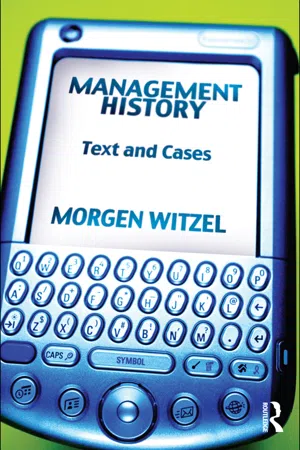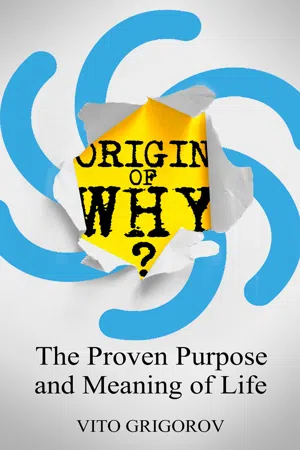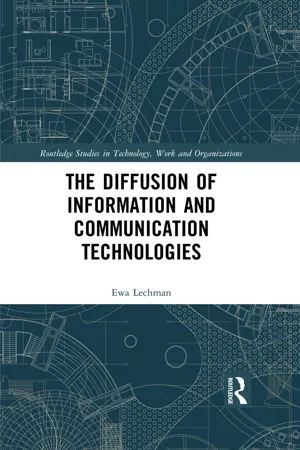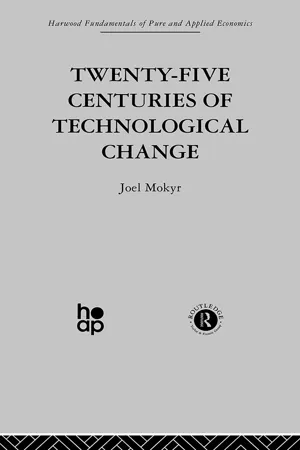History
Technological Innovations
Technological innovations refer to the development and implementation of new or improved technologies that have a significant impact on society, economy, and culture. Throughout history, technological innovations have driven progress and change, shaping the way people live, work, and interact with the world around them. These innovations have included advancements in areas such as transportation, communication, medicine, and manufacturing.
Written by Perlego with AI-assistance
Related key terms
6 Key excerpts on "Technological Innovations"
- eBook - ePub
Management History
Text and Cases
- Morgen Witzel(Author)
- 2010(Publication Date)
- Routledge(Publisher)
Managers in the past were well aware of the importance of all three. Though the pace of technological change increased steadily from the late eighteenth century onward, technological advances had been occurring slowly but steadily for centuries. The progression from stone to bronze and then to iron tools, for instance, was a technological revolution in its own right, as was the efficient harnessing of water power in the Middle Ages. Each advance in technology saw innovations in terms of new products, new production processes, sometimes new industries and markets. And beyond these revolutions, progressive businesses were constantly engaged in the search for ways to improve, to go beyond what already existed, to put distance between themselves and their competitors. Similarly the importance of knowledge has long been recognised, even if its role was not clearly understood.The pace of change in all three fields picked up greatly during the Industrial and Scientific Revolutions that began in the late eighteenth century, and even more so in the late twentieth century with the advent of the computer age. Our technologies are far more complex than those of earlier times, and we have much more knowledge at our disposal – although it is not yet clear if this has made us any more innovative! In some respects we are now glutted with both knowledge and technology, and many of us strive to make sense of and use effectively the resources we have. Perhaps it is fairer to say that the face of innovation has changed. In former times, innovators made do with a limited amount of knowledge and technology: the contest was to see who could use these most effectively. Today the process has become more oriented towards pattern recognition: innovators look around at our complex world and search for things that they can use to create new products or new value.7.2 Technological advances
We begin with a look at technology itself, how it has advanced and changed, and in particular how those changes have impacted on management. It should be emphasised that what follows is not a history of technology itself. - eBook - ePub
- Marianne Chouteau, Joelle Forest, Céline Nguyen(Authors)
- 2018(Publication Date)
- Wiley-ISTE(Publisher)
1 A Brief History of European Technical Culture and Its Relationship with Innovation 1.1. Introduction What the two historical approaches to innovation and technology have in common are that they both reveal a difference in their emergence and evolution, both factually and conceptually. To invent is a constant in human history. “The innovator is a leader who does not have to act (prattein), he governs (archein) those who are capable of executing”, wrote Plato in Le Politique [ARE 94]. On the other hand, objectifying innovation and building a dedicated culture around it is more difficult than the act of innovating. It is the same for technical fact. Technical fact, tangible and/or intangible, has been a part of the history of human societies since the dawn of time. Nevertheless, human societies do not necessarily objectify the technical fact, even nowadays. Human societies often appropriate the technical fact without developing a technical culture. Actually, the history of the regimes of technical fact appropriation shows the late emergence of a distancing from the techniques [GAR 15]. Let us take Europe as an example. Its material and cultural history experienced profound ruptures between the 16th and 18th Centuries: the first world expansion in the 16th Century, the advent of modern science in the 17th Century and the compelling development of industrial capitalism in the 18th Century. We would expect that such changes would have been made in an innovative mind and that they would have been accompanied by a culture that glorified innovation. This is what happened, but only partially. The Theaters of Machines, written by engineers and published between the 16th and 18th Centuries, praised the novelty and put it forward [VER 03]. The many technical treatises published in the 17th Century insist on their innovative character. In the 18th Century, encyclopedists pleaded for the expansion of knowledge maps. Yet innovation was unanimously condemned - eBook - ePub
Origin of Why?
The Proven Purpose and Meaning of Life
- Vito Grigorov(Author)
- 0(Publication Date)
- Prosperist Publishers(Publisher)
In a chat with Jen, Kate sees that without other innovations she’d not be able to program her software. Maybe her software can do the same and inspire other innovations into the future?Historical Innovation Combination (x)
What evolution has done to unify the natural world, we will try to do to unify the social world. We see the engine that’s driving history as innovation combination. The more innovations people can use, the more actions occur, and so the more likely it will be that innovations will continue combining.Yet if there are no new combinations, society is forced to use the same old innovations and do the same actions as were done centuries ago. Little or no change in actions means little change in history, as we see from those rare Amazonian tribes which use the same tools their ancestors did. Being cut off from the world means fewer innovations mix with the ones they use. Also, it leads to less chance for life expectancy or living standards to grow. North Korea is a modern example of this. The more a nation isolates itself from the world’s innovations, the worse off it becomes.To understand this historical process, definitions spread throughout our book are now combined into one place.- Actions – Movement of the human body.
- Innovation – That help us reach a result and so lead to action.
- Entrepreneur – Maker of the innovations.
- Value – How innovations are chosen, through the Time, Money, Health, Intelligence factors.
- Productivity – Measure of the change in value factors as seen in our actions.
1. Actions – Movement of the human body.Without any actions, human history cannot happen, becoming motionless like a ghost town.2. Innovation – That help us reach a result and so lead to action.When a movie is set in 1612 England, the backdrop and props need to be from that time period to make it look realistic on screen. It’s the amount of combination among innovations that shows us if a location has advanced or declined. Similar to natural selection in biology, in the manmade world it is unproductive and counterproductive innovations that mostly die, while the productive live. - eBook - ePub
- Jay Mitra(Author)
- 2017(Publication Date)
- SAGE Publications Ltd(Publisher)
1 An Introduction to Technological Change and InnovationScope and Objectives
- An introduction to the meaning and significance of technological change for innovation, growth, economic and social development.
- A focus on developed economies where technological change has been most pronounced in the last two centuries.
- Critical appreciation of underpinning economic theories that help to explain the relationship among technological change, the knowledge production function, exogenous and endogenous growth, spillover effects, innovation and economic growth.
- An understanding of the contexts of technological change and the significance of organisational and social change generated by advances in technology and innovation.
Introduction
The connection between innovation, entrepreneurship and technical change is predicated upon the idea that their mutual interdependence leads to improved economic performance at the level of the firm, the industry, the region and the nation. Changes in technology and their use enable the creation of new products and services. The mobilisation of resources through the formation or growth of firms characterises the entrepreneurial process which brings these new products and services to the market. With the gradual diffusion of these innovations, incumbent technologies and businesses give way to new and more productive counterparts. Firms enjoy higher levels of productivity, consumers take advantage of either cheaper or better value products and services for which they may be willing to pay more, new jobs are created, we obtain a better quality of goods and services, and the gross domestic productivity of the nation increases over time. Technical advance prompts the creation of new products and services, the formation of new firms, and economic growth.Economies grow because of numerous factors that enable growth to occur. Increases in market size enable increases in gains from trade, resulting from the division of labour and competitive resource pools. Investment in physical and human capital causes economic growth. Another key source is technological change (Lipsey et al., 2005). Understanding how the growth process is linked to technical change, innovation and entrepreneurship is vital for any business and policy makers. Understanding the drivers and effects of innovation and entrepreneurship is critically important because we are all conscious of the fact that technical change is related to improvements in performance at the level of the individual business, the industrial sector in which the firms are located, and at the regional and national levels (Link and Siegel, 2007). - Ewa Lechman(Author)
- 2017(Publication Date)
- Routledge(Publisher)
a process of active development of technology, especially designed to save labor in different areas ’ (Grinin & Korotayev, 2015, p. 52). Undeniably, technological revolution gives a positive impulse to wealth creation economy-wide; it provides a wide array of novel infrastructure and allows for organizational improvements, thus enforcing productivity shifts. Technological breakthroughs not only bring purely technically new solutions to society and economy, meaning that their influence is not purely technological, but also introduce innovations on organizational grounds and then induce significant social, economic and institutional changes. Once a technological revolution appears, it is gradually assimilated in the economy and social system, which generates great surges of development and these are then followed by transformations and modifications in social, institutional and economic spheres of life. Technological revolutions diffuse; they expand across societies and economies and, hence, generate the ‘great surges of development ’ (Perez, 2002). ‘Each (…) revolution has driven a great surge of development that takes a half of century or more to spread unevenly across the economy’ (Pereze, 2004b, p. 21). Each great surge of development , as a time-related process, unveils certain regularities, and it encompasses two consecutive periods (phases): the installation period and deployment period. The initial (installation ) phase is sometimes compared to the Schumpeterian ‘creative destruction’, which means nothing more than the fight of new ideas (technologies) against the old concepts (technologies). Schumpeter writes, ‘The process of industrial mutation (…) that incessantly revolutionizes the economic structure from within, incessantly destroying the old one, incessantly creating a new one ’ (Schumpeter, 1943, p. 83). To some extent, the period of installation is an experimental period, during which new technologies try to evade the market and are either accepted or rejected by socio-economic systems. These times of creative destruction are extremely turbulent and marked by periods of instability, during which the old regimes are being gradually eliminated from the market, while the new regimes and technological solutions abruptly irrupt and pervasively evade existing social, organizational, financial and institutional frameworks. The installation period is additionally marked by fast diffusion of innovations, and, hence, they are assimilated and then adopted by a constantly growing number of new users. During the installation phase, new industrial, new modes of production and infrastructure, new ways of doing business or even new products and inputs are widely articulated. The installation period sets up a new common sense (Perez, 2014) across the society and economy, and this period often generates huge inequalities among countries. In other words, the world becomes more differentiated and polarized because of sequentially emerging technological revolutions. The installation period is then followed by the deployment- eBook - ePub
Twenty-Five Centuries of Technological Change
An Historical Survey
- J. Mokyr(Author)
- 2013(Publication Date)
- Routledge(Publisher)
66 Instead, I will try to take up Heertje’s challenge cited in the introduction to this survey, and ask how we can come to grips with technological progress as an economic phenomenon dominating economic history in the past twenty-five centuries.The framework and historical survey outlined above suggest that technological change is sufficiently heterogeneous to defy simple generalizations. That does not imply that I agree with the undertone of defeatism implicit in Heertje’s statement, that technological change cannot easily be explained. What is important is to separate the different forms technological change takes, and to emphasize that the different forms are subject to different forces. A theory of technological change should be as simple as possible but, as Einstein said in a different context, not simpler. The first distinction we have to make is well known: there is a difference between being imitative and innovative. An imitative society will adopt new techniques wherever they come from, as long as the technique is demonstrably superior. An innovative society is capable of creating new techniques, but does not necessarily apply them itself with great success. Innovation and imitation were both manifestations of technological creativity, but they did not always coincide precisely. Until recently, for example, it was widely believed that the industrial nations of East Asia were only capable of technological creativity through imitation, but could not innovate anything themselves. We know better now, but the prejudice is symptomatic of the difference between the two. Similarly, during the late eighteenth century, France and Britain were both innovative in the sense that they generated a stream of inventions amounting to what we call today an industrial revolution. But although both countries were innovative, Britain was by far more creative. Inventions were adopted faster, and the old economic status quo was overthrown at a quicker pace. In its early decades, the United States was imitative rather than innovative (Wilkinson, 1963). Another society which appears to be more imitative than innovative was early medieval Europe. It adopted, improved, and refined technologies it inherited from the Romans or borrowed from the Middle East or the Orient. Until it invented the weight-driven clock and the spinning wheel, it made few major inventions of its own.
Index pages curate the most relevant extracts from our library of academic textbooks. They’ve been created using an in-house natural language model (NLM), each adding context and meaning to key research topics.





